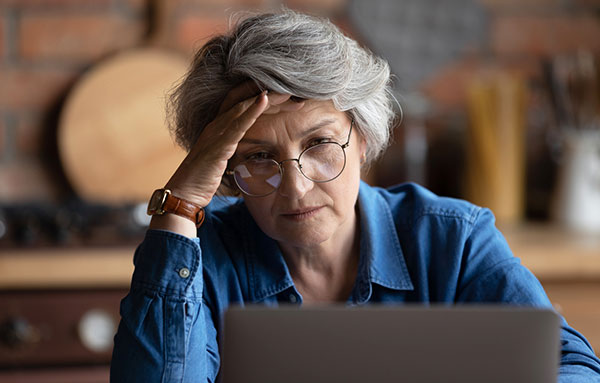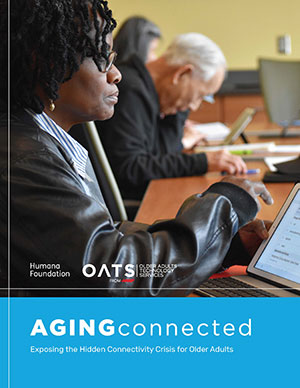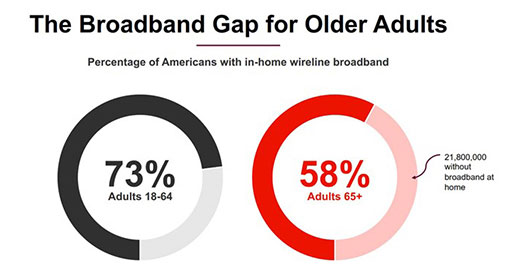Older Adults and the Digital Divide: A Social Justice Crisis

A recent American Society of Aging conference was full of news about the digital divide and how the pandemic has disproportionately affected older adults. Almost every life task for the last year has necessitated having a high-speed Internet connection plus a device and the skills to use it—homeowners association meetings, food delivery, banking, even doctor’s appointments and services for faith communities.

Click on the image above to open “Aging Connected: Exposing the Hidden Connectivity Crisis for Older Adults,” OATS and AARP, 2021.
On the policy level, people are advocating to treat high-speed Internet as an essential utility, like clean running water and electricity. Disappointingly, the U.S. lags many other countries in the availability of broadband. Not all older adults are affected equally—as someone put it, “we are all in the same storm, but we are not in the same boat.”
Check out these stats from OATS (Older Adults Technology Services—aka Senior Planet), which recently joined forces with AARP:
- Older adults who live in rural areas are 1.6 times more likely than those in more populated areas to be offline.
- People of African descent are 2.6 times more likely than White people to be offline.
- Latinx people are 3.4 times more likely than White people to be offline.
- People with low incomes are 10 times more likely than those with higher incomes to be offline.
To help fill these needs, the King County Library System (KCLS) is working with community partners on a “Digital Bridge” hotspot and laptop-lending program reaching low-income older people, immigrant entrepreneurs, and people experiencing homelessness (many of whom are older adults). Since having a connection and a device is not enough, we also provide “digital navigators“ for one-on-one assistance. These navigators are available on an appointment basis to help people find low-cost Internet, devices, and resources to learn the digital skills they need.

This image was part of “Linking Digital Engagement to Social Determinants of Health,” a presentation by Thomas Kamber, founder and executive director of OATS and Senior Planet, at the American Society on Aging’s On Aging 2021 conference, April 15, 2021.
The KCLS Foundation and library staff are working diligently to help people get online and so their needs can be met. Recently I spoke to an older patron who described our hotspot-lending program as “a godsend” and “a lifesaver.”
KCLS is fulfilling its strategic focus to “connect people with information and services to navigate life’s complexities and biases” by helping them succeed online. It takes all of us!
Contributor Wendy Pender is the Older Adults Program Coordinator for the King County Library System. She welcomes questions at wgpender@kcls.org.
![AgeWise King County [logo]](https://www.agewisekingcounty.org/wp-content/themes/agewisekingcounty/images/logo.png)